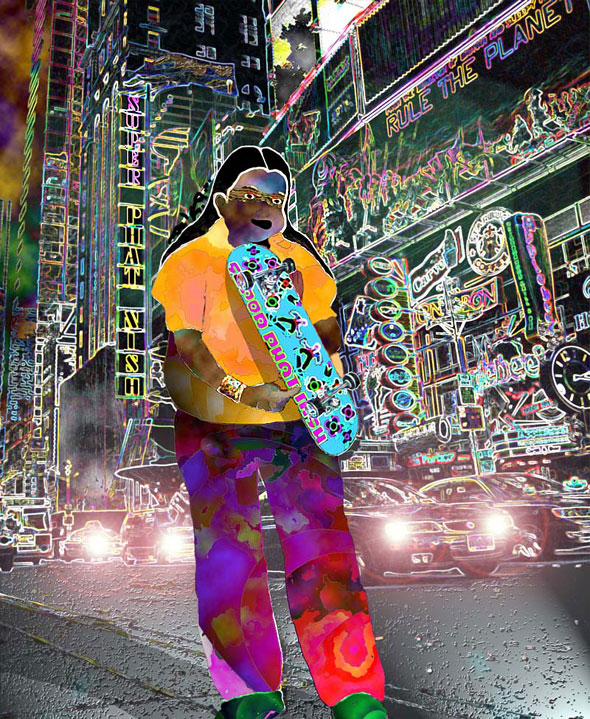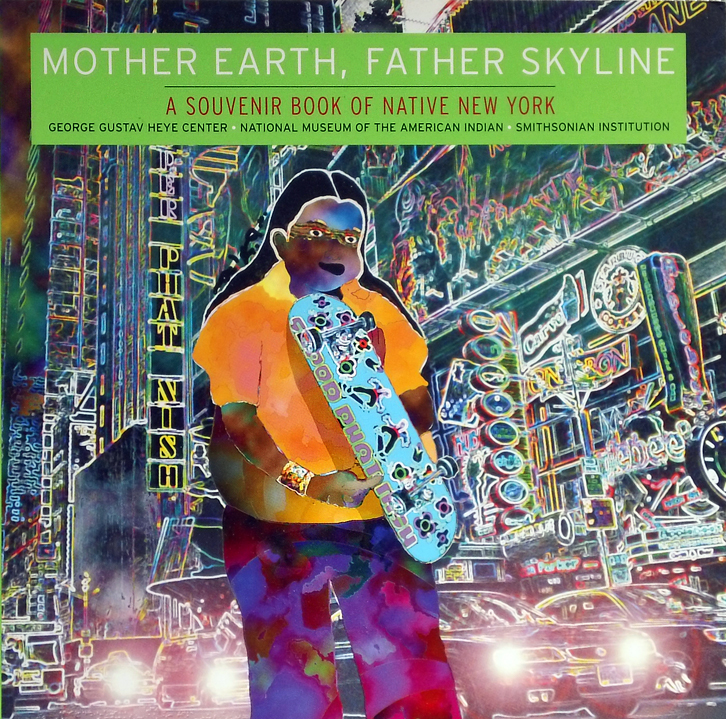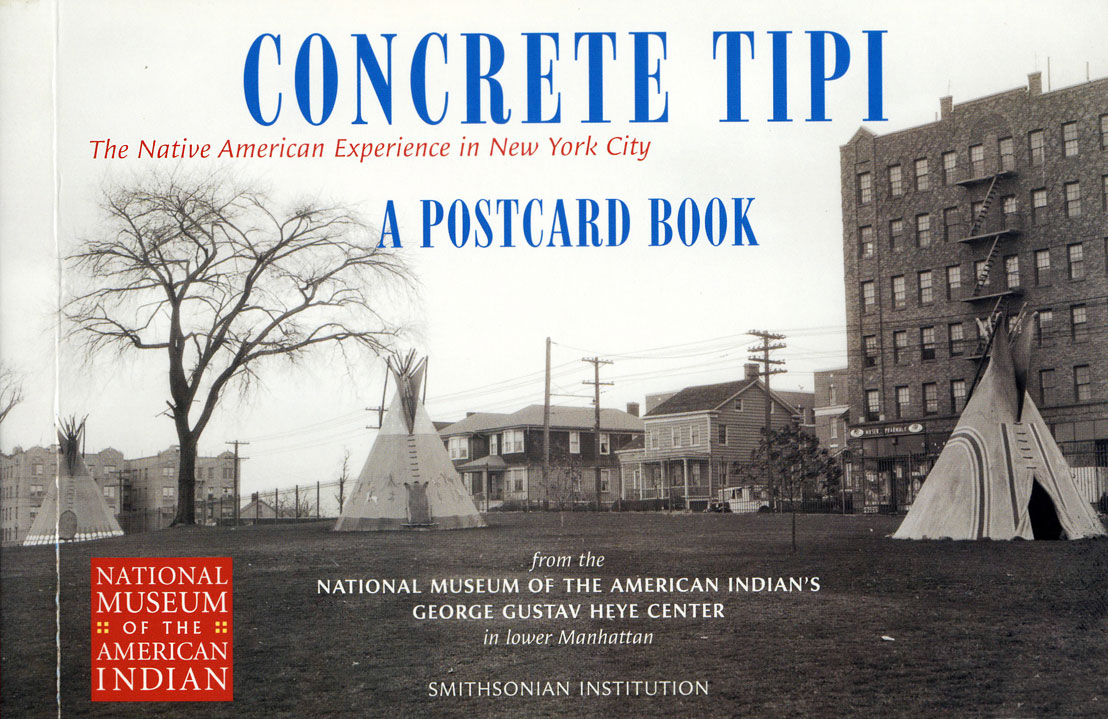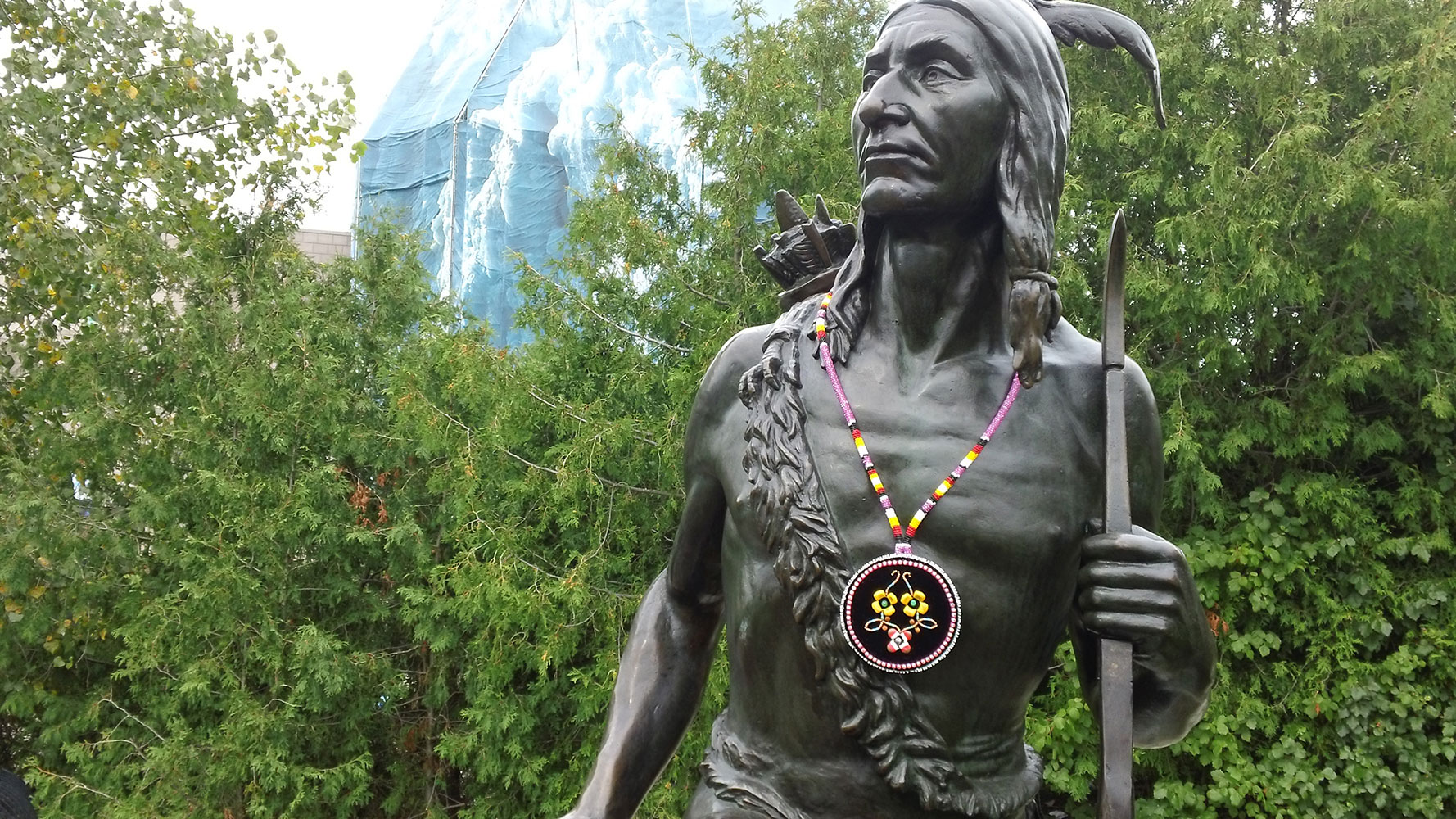L.A. Pai Gallery (Ottawa) has placed two of Ace’s digital prints: Forty-Deuce Redux (2013) and Kitchi Zibi Omàmìwininì Anishinàbe (2017) ed. 1/2 in the corporate art collection of Richardson Wealth, a leading independent wealth management group in Canada. L.A. Pai was invited to recommend and curate a selection of 50 plus artworks from L.A. Pai’s stable of artists for Richardson Wealth’s new Queens Quay waterfront corporate offices.
Created in 2013, Forty-Deuce Redux (2013) responds to a larger body of work from 2006 by Ace under the moniker Super Phat Nish which is a series of mixed media paintings, textile and assemblage addressing the urban Indigenous experience, through the creation of a popular culture icon. Based on the Anishinaabe mythological trickster Nanabozho, SPN is a self-reflexive personification constantly transforming to engage, critique, and indiginize normative settler imagery. The shape-shifting SPN can be perceived as humorous and ironic, yet simultaneously, there is a subversive subtext that levels cultural critique against dominant narratives. SPN reclaims stereo-typical representations to challenge negative racial portrayals through a repositioning that coalesces with contemporary Indigenous urbanity. ‘Super Phat’ (cool and hip) combines with ‘Nish’ (cajoling street-smart term for Anishinaabe) to reference belonging and tribalism.
In 2022, Super Phat Nish was brought back into public view in the Canada Council Art Bank 50th anniversary exhibition Looking the World in the Face. Guest curator Amin Alsaden included Ace’s SPN work Cashing In and comments on the exhibition that “Looking the World in the Face examines cultural representation in the Art Bank collection and honours the significant contributions Indigenous and racialized artists, who have been historically underrepresented, have made to Canada. The works are about more than mere visibility or self-portrayal. They are acts of valiant resistance and generous affirmation by artists who insist on being seen.”
Kitchi Zibi Omàmìwininì Anishinàbe (2017) ed. 1/2 is a work that responds to the controversy surrounding public monument, in particular the Anishinaabe Scout who use to sit at the based of the Champlain monument at Nepean Point in Ottawa. The Assembly of First Nations (AFN), under former National Chief Ovide Mercredi, felt that the Hamilton MacCarthy sculpture was racist and derogatory and he lobbied the Federal Government (National Capital Commission) to have the Scout removed. While many Indigenous and non-Indigenous people agreed, there was also another Indigenous camp that included artists who disagreed with AFN’s position and felt the removal of the Scout would only rewrite and further subvert this racist colonial history.
In the end, the National Capital Commission dismantled Hamilton MacCarthy’s sculpture and relocated the Scout for a short period of time to a small patch of reserve-like land in Major’s Hill Park outside of the National Capital Commission’s commercial leased property “Tavern on the Hill” in the Gardener’s House. Ironically, the Scout was now even further below the horizon-line of the Champlain monument (and arguably was still subservient in a mythical hinterland). As of 2023, both Champlain and the Scout have been removed to storage, as Nepean Point undergoes a major renovation. It is highly unlikely that MacCarthy’s Champlain monument with Scout will be brought back into public view, and in effect, erases important dialogue of Canada’s unsettling colonial history.
For the digital photograph of the Scout, Ace strategically placed around the neck of MacCarthy’s sculpture one of his signature contemporary digital bling medallions as a decolonial gesture of intervention. In the background, a glimpse of a foreshadowing glacial iceberg beyond the cedar tree-line. This outdoor work is entitled Iluliaq: a monumental work by Greenlandic artist Inuk Silis Høegh that engulfed the exterior of Great Hall of the National Gallery of Canada (NGC) in 2013 for the Sakahàn: International Indigenous Art.
 Installation view at the Toronto corporate offices of Richardson Wealth. Photo Courtesy of L.A. PAI and Richardson Wealth.
Installation view at the Toronto corporate offices of Richardson Wealth. Photo Courtesy of L.A. PAI and Richardson Wealth.  Installation view at the Toronto corporate offices of Richardson Wealth. Photo Courtesy of L.A. PAI and Richardson Wealth.
Installation view at the Toronto corporate offices of Richardson Wealth. Photo Courtesy of L.A. PAI and Richardson Wealth.  Forty-Deuce Redux 1/1 (2013) 118cm x 142cm, digital output. Collection of Richardson Wealth (Toronto).
Forty-Deuce Redux 1/1 (2013) 118cm x 142cm, digital output. Collection of Richardson Wealth (Toronto).  Cover for “Mother Earth, Father Skyline,” National Museum of the American Indian, Smithsonian, New York, New York, USA (2006)
Cover for “Mother Earth, Father Skyline,” National Museum of the American Indian, Smithsonian, New York, New York, USA (2006)  “Concrete Tipi,” National Museum of the American Indian, Smithsonian, New York, USA (2006)
“Concrete Tipi,” National Museum of the American Indian, Smithsonian, New York, USA (2006)  Installation view at the Toronto corporate offices of Richardson Wealth. Photo Courtesy of L.A. PAI and Richardson Wealth.
Installation view at the Toronto corporate offices of Richardson Wealth. Photo Courtesy of L.A. PAI and Richardson Wealth.  Installation view at the Toronto corporate offices of Richardson Wealth. Photo Courtesy of L.A. PAI and Richardson Wealth.
Installation view at the Toronto corporate offices of Richardson Wealth. Photo Courtesy of L.A. PAI and Richardson Wealth.  Kitchi Zibi Omàmìwininì Anishinàbe (2017) Edition (1/2) 92 (h) x 56 (w) cm, digital print on rag paper. Collection of Richardson Wealth (Toronto). 2/2 Available for purchase at L.A. PAI Gallery.
Kitchi Zibi Omàmìwininì Anishinàbe (2017) Edition (1/2) 92 (h) x 56 (w) cm, digital print on rag paper. Collection of Richardson Wealth (Toronto). 2/2 Available for purchase at L.A. PAI Gallery.